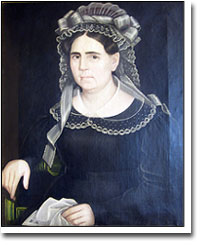Artists without formal art training have been producing folk art for centuries. But it wasn’t until 1924 that the first American folk art exhibition was held at New York’s Whitney Museum of American Art (then called the Whitney Studio Club). The genre has been growing in popularity since the 1920s, and now interest in American folk art is at an all time high.
Some dealers and artists are cashing in by passing off newer pieces as century old folk art.
Here we highlight five questions to ask about folk art, to ensure what you’re paying for:


Is it signed?
Most folk art isn’t, so be cautious if the painting has a signature. Signatures from well-known folk artists, such as Ammi Phillips or Joseph Whiting Stock, are often forged. Use a reference book to compare the signature on the painting to a real one.
What’s the back look like?
It’s difficult to estimate the age of an unsigned and undated painting. For a clue, take the painting off the wall and inspect the back. The stretcher, lining, and other physical materials are good indicators of age. Some paintings that appear to be folk art were manufactured within the last 30 to 40 years. New-looking materials are a good tipoff.
Where was it made?
Stylistic characteristics of a painting can indicate where it was created. Some regional styles — the Prior-Hamblin school of Fall River, Massachusetts for example — are more recognizable and sell for higher prices.
How old is the subject?
Many folk art paintings are portraits, and those of children are more sought after than images of the elderly. Often a child is depicted holding a toy or flower, which can be a symbol of innocence or the child’s death. Portraits of children are generally considered more charming than those of adults, and charm is what sells folk art. Because the artist is often difficult to identify, folk art is appreciated mainly for its decorative value.
What’s the price?
Folk art has become so popular in recent years that it’s difficult to find a “sleeper.” Underpriced paintings are rare, and a buyer is hard pressed to find a painting in good condition for less than $1,000 to $2,000.
The value of American folk art, like any form of art, can vary widely depending on several factors, including the artist’s reputation, the historical significance of the piece, its condition, and the demand in the art market. Here are some factors to consider when determining whether American folk art is worth buying:
Artist and Provenance: Folk art created by well-known artists or those with a documented history of craftsmanship often commands higher prices. Research the artist’s background and the provenance (the history of ownership) of the piece to assess its value.
Rarity: Unusual or rare examples of folk art can be more valuable because they are in higher demand among collectors.
Condition: The condition of the artwork is crucial. Pieces in excellent condition tend to be more valuable than those with damage or significant wear.
Historical and Cultural Significance: Folk art pieces that are historically or culturally significant may have a higher value. They can provide insights into the time and place in which they were created.
Aesthetics: Personal taste plays a role in determining the value of folk art. What appeals to one collector may not appeal to another. If you are drawn to a particular piece, it may be worth more to you personally.
Demand and Trends: The art market can be influenced by trends and collector preferences. Research the current market for American folk art to gauge demand and potential appreciation in value.
Appraisals and Expert Opinions: Consider seeking the advice of experts or appraisers who specialize in American folk art to get a professional opinion on a piece’s value.
Investment vs. Enjoyment: Some people collect art as an investment, while others do it for the joy of owning and appreciating the pieces. Keep in mind that the value of art can be unpredictable, and it’s not always a guaranteed investment.
Ultimately, the decision to buy American folk art should be based on your personal interest in the piece, your budget, and your understanding of the factors that affect its value. If you are passionate about folk art and are willing to do the research, you can find valuable and meaningful pieces to add to your collection.
Further Reading:
Clementine Hunter: American Folk Artist by Clementine Hunter, James Lee Wilson
Painting by Heart: The Life and Art of Clementine Hunter, Louisiana Folk Artist by Shelby Gilley
Painting American Folk Art by Andy Jones
Mississippi Quilts by Mary Elizabeth Johnson, J. Schwalm
Inuit Art: An Introduction by Ingo Hessel
Grandma Moses in the 21st Century by Jane Kallir
North American Indian Artifacts: A Collector’s Identification & Value Guide by Lar Hothem
Braided Rug Book: Creating Your Own American Folk Art by Norma Sturges
Country Arts in Early American Homes by Nina Fletcher Little, Wendell Garrett
The Keepers: Mountain Folk Holding on to Old Skills and Talent by Robert Isbell, Arthur Tilley
Real American Folk Songs by Max Morath; Audio CD
Related stories
The market for 20th-Century Latin American Art
German Expressionism: Art Born of Self-Expression





